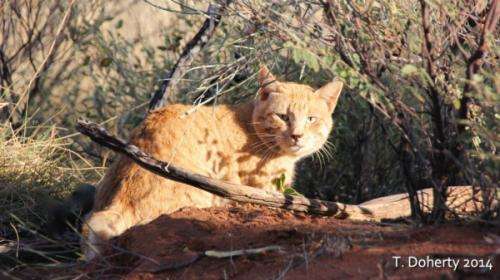Field tests needed to help control feral cats

Local wildlife ecologists have analysed research into feral cat habitat use from around the world in a bid to better manage the pest, which is one of the major threats to biodiversity globally.
Edith Cowan University Wildlife Ecology PhD candidate Tim Doherty led a team of researchers which reviewed 27 studies conducted over the past 35 years.
The team produced a number of hypotheses they would like to be tested by future research to fill important knowledge gaps in the field.
Foremost is the theory that predation and competition for food most strongly influences cat habitat use.
For example, competition for food with high-order predators like dingoes, may limit cat numbers.
Others factors (shelter, prey, and resource subsidies like food from humans) are increasingly important when predators are absent.
However, Mr Doherty says most of the studies which were reviewed were observational.
He says more experimental research is needed to help control feral cat populations.
"Ideally you want a landscape-scale experiment where you control and manipulate certain factors like prey and shelter availability," he says.
"Hopefully people in the future will employ more rigorous approaches to get a firmer understanding of the driving factors and ultimately lead to better management."
Pests claim 22 mammal extinctions
Feral cats have contributed to at least 22 mammal extinctions out of 30 in Australia since European settlement, including the Desert Bandicoot (Perameles eremiana) and Lesser Bilby (Macrotis leucura).
Worldwide, they have contributed to at least 14 per cent of bird, mammal and reptile extinctions.
The reviewed studies investigated feral cats in Europe, America, New Zealand and Australia spanning habits that included forest, woodland and agricultural lands.
However, Mr Doherty says there remains a lack of understanding about their habitat-use.
"Feral cats are the number one threat to Australia's mammal species and we need to be doing much more to reduce the impact," he says.
"If we understand which parts of landscape they use, we can target control actions into those areas—for example it might be that cats like to walk along roads, so we can put traps or baits in those areas," he says.
The study established six key research directions particularly around the predator and prey dynamic.
It also proposes three key management strategies emphasising plans that incorporate more in-depth research about prey availability.
"So rather than make this a one-size-fits-all model, what we aim to do is provide these key directions to inform future management and future research," he says.
More information: www.publish.csiro.au/nid/144/paper/WR14159.htm
Provided by Science Network WA
















